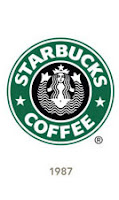Apple
First Logo, 1976-1976
The first apple logo features Isaac Newton under an apple tree;
it wasn't used for very long because of the way it didn't look like the kind of
logo you’d expect from a computing company. It is using the Isaac Newton scene
because it features the apple and a person that at the time ‘thought different.’
‘Think different’ is the Apple company slogan.
Second logo, 1976-1998
This is the first one with the still used half eaten
outline. This one features a rainbow colour scheme. The bite could have
represented a play on words as byte/bite because a byte is a unit of digital information.
The colours are in no particular order apart from the green at the top because
green is the colour of the leaf.
Third Logo, 1998-present
This logo maintains the Apple outline used in the second one
but has a colour change and is given a third dimension. The logo is colourized grey and is made to
look almost clear and glassy, but it still can look metallic. The logo also is
looks like it’s popping out of the media.
Microsoft Windows.
First Logo, 1985-1991
Second logos, 1992-2000
The second logo is quite different
from the first one, it has multi-coloured window panes and darker outlines for
the beams between the window panes. It
also has a wavy effect. And a particle
trail.
Third Logo, 2001-2011
The fourth Microsoft Windows logo
is very similar to the first logo, it has the same colour scheme as all the
window panes are a light blue colour to make the panes look more “glass like.”
The logo is also quite unbalanced because the logo as a hole appear s to go
back to a focal point making the logo smaller on one side.
KFC
The first KFC logo is spelt out in
full as “Kentucky Fried Chicken” with the famous Colonel Sanders face logo. It
uses a very 1950’s looking font which is why the second logo is pretty much
just an updated font and the face has been relocated.
Third Logo 1991-1996
 The third logo used by KFC has the
Kentucky Fried Chicken abbreviated to KFC and is now using the red and blue
colours KFC typically uses. It still keeps the Colonel Sanders face in the same
position as the other two but now uses blue instead of black as the outline.
The third logo used by KFC has the
Kentucky Fried Chicken abbreviated to KFC and is now using the red and blue
colours KFC typically uses. It still keeps the Colonel Sanders face in the same
position as the other two but now uses blue instead of black as the outline.
Fourth Logo - Present
The Colonel Sanders face has been altered
slightly, to make him face a different direction and is reverted back to black
outlines for the face, he also now is wearing an apron. The colour blue has been removed completely
and there are no words left either because of how famous the face has become.
Starbucks
First Logo
The first logo of Starbucks has a
mermaid in the middle of a brown circle with the words “Starbucks – Coffee –
Tea – Spices. They sold these before they became a coffee enterprise. They
probably used brown because that is typical the colour of coffee and tea.
Second logo
 The original words of “Starbucks –
Coffee – Tea – Spices” have just been replaced with Starbucks – Coffee. The
outside circle is green and the inside picture is white on a brown background.
The mermaid has also been changed from a detailed picture to a more simplified
mermaid.
The original words of “Starbucks –
Coffee – Tea – Spices” have just been replaced with Starbucks – Coffee. The
outside circle is green and the inside picture is white on a brown background.
The mermaid has also been changed from a detailed picture to a more simplified
mermaid.
The third logo is almost
completely the same as the second logo but the mermaid has been zoomed in on so
the majority has been cut.
Fourth logo







